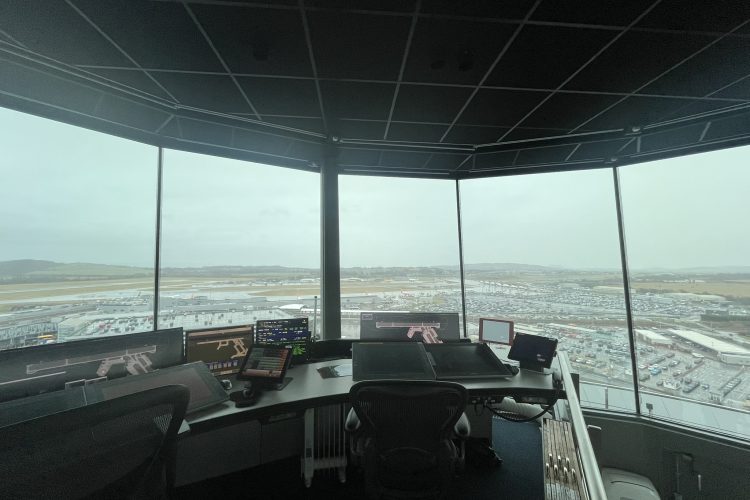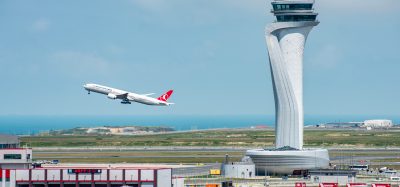A day in the life of an Air Traffic Controller, with Air Navigations Solutions Limited (ANSL)
- Like
- Digg
- Del
- Tumblr
- VKontakte
- Buffer
- Love This
- Odnoklassniki
- Meneame
- Blogger
- Amazon
- Yahoo Mail
- Gmail
- AOL
- Newsvine
- HackerNews
- Evernote
- MySpace
- Mail.ru
- Viadeo
- Line
- Comments
- Yummly
- SMS
- Viber
- Telegram
- Subscribe
- Skype
- Facebook Messenger
- Kakao
- LiveJournal
- Yammer
- Edgar
- Fintel
- Mix
- Instapaper
- Copy Link
Posted: 13 May 2024 | Chunekshi Wimalasuriya | No comments yet
International Airport Review were invited to Edinburgh Airport to take a tour of their air traffic control (ATC) department, operated by Air Navigation Solutions Limited (ANSL).


Radar ATCO's view of the airfield from their desk (nicer on a sunnier day, don't you think?)
Different roles in ATC
We had the opportunity to speak to radar and airside operations ATCOs and learnt of differences between their roles. Radar ATCOs would communicate directly to an individual pilot, informing them of the safe altitude/distance to start ascending and descending. We got to experience this process first-hand; our conversations would sometimes be interrupted with a cackle of a pilot’s voice over the room’s radio. The ATCO would then swivel in his chair, loop on a headset and fiddle with grey screens and switches as they responded back with ATC jargon (“alpha-lima foxtrot, you can ascend now”).
Radar ATCOs explained that they oversaw the controlled airspace, monitoring all aircraft and flagging any that looked unrecognisable. The team were also responsible for sequencing; a process where ATCOs use speed control to create minimum space between aircrafts and ensure a safe, smooth flow. During busy summer travel periods, this became challenging because more and more aircraft entered Edinburgh Airport’s airspace and ATCOs had to monitor this attentively to prevent incidents.
Airside operations ATCOs had the joy (though radar ATCOs would say otherwise) of speaking to multiple pilots broadly and assisting them with their take-off/landings. These ATCOs would manage the expectations and queries of pilots to facilitate even cooperation. Airside ATCOs sat at the top of the control tower, overlooking Edinburgh Airport’s stunning airside view.
What it takes to be an ATCO
When asked about how they initiated, many ATCOs said they came from a military background, and this helped them develop the transferrable skills to pursue air traffic control professionally. Some worked in the aviation departments of the Royal Air Force, the Navy or the Army. Many also stated that once they had a brush with air traffic control, they fell head over heels for the industry and stayed, with some having worked for decades.
For individuals who didn’t have a military background, they had to train and pass a series of courses to be certified. Trainees had to take rigorous exams and practical examinations and, depending on these successes, could expect to pass at any time from 18 months to two to three years!
To gain further insight into this training process, we were shown flight simulations instrumental in training ATCOs. These simulations would play out weather-related (fog pockets, heavy rainfall) or man-made (plane on fire, collisions) incidents and this would give ATCOs a sense of how to properly respond if such events were to occur in real time. They were interactive too – trainees could use a joystick to ‘fly’ across the airspace or sit at different perspectives, like as a pilot in the cockpit or a ground handler.
Safeguarding an ATCO
Having to problem solve to tight deadlines, oversee airspaces and manage the safety of pilots and passengers, all while following strict protocol shows that this job can exhaust an individual’s physical and mental wellbeing. To bar this, ANSL explained some of the safeguarding policies they had implemented.
Speaking to Vicky Bhogal-Hunt, the Head of Air Traffic Services at ANSL, we got an understanding of ATCOs’ working hours and weekly rosters. ATCOs, stated Bhogal-Hunt, “can’t work more than two hours in the seat and must have a 30 minute fatigue break after”, and the organisation of seating plans afforded this working pattern to every individual.
It’s common for ATCOs to work “six days and have four days rest” allowing for a good period of respite. Additionally, ANSL ensures a good rotation of controllers so that, if “ad hoc you need to remove somebody from the seat as they’ve had quite a complex piece of traffic to deal with, although they’re not actually due a break for another hour and a half, you’ve got the ability to do that.” Bhogal-Hunt’s comments demonstrated the priority ANSL places on the wellbeing of their controllers and that they are making efforts to retain these workers.
Airfield tour around Edinburgh Airport
Arguably the most exciting part of our trip was the tour of Edinburgh Airport’s airside field, which – by witnessing some of their projects – gave us an insight into the airport’s future plans.
Touring the space by car, we passed a huge expanse of solar panels; long, blue rectangles of metal propped up by grey stilts that would one day provide Edinburgh Airport with solar-generated energy. Our tour ATCOs explained that we were seeing the initial stages of the airport’s sustainability roadmap, and that it would be a few years before the panels would be put to use.


Solar panels at Edinburgh Airport.


It would be some time until these solar panels would come to use.
We passed a large bullet-shaped blue extinguisher that was used by firefighters to mitigate fires. Paired with this were decimated cars, cordoned off by barbed wire – the training ground for firefighters to practice how to get passengers out of burning aircraft, safely and quicky. These grounds expressed the airport’s commitment to safeguarding passengers.


The airport’s bullet-shaped blue extinguisher used for fires.
International Airport Review encountered flight take-offs and landings at close proximity during the final leg of our airfield tour. We saw airlines like Aer Lingus, easyJet and Qatar Airways take-off/land, and saw aircraft shaking haphazardly in the air as they combatted the high-speed winds Edinburgh was experiencing that day to touch ground. However, the expert training of the pilots controlling these aircraft was evident as they all made a smooth landing despite the shaky approach.
The trip was a great opportunity for International Airport Review to get an in-depth focus into the world of air traffic control. We came, hoping to get a basic understanding of ATC operations, but instead were left enlightened by the incredible skills of these individuals who work behind the scenes to ensure the safety of passengers and aircraft. They drive the industry forward with strength, loyalty and commitment to their craft.
What do you think about our tour across Edinburgh Airport’s ATC department? Let us know in the comment section below.
Related topics
Air traffic control/management (ATC/ATM), New technologies, Social responsibility, Workforce



















